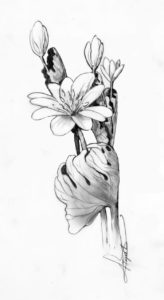By Meghan McCarthy McPhaul
Every spring, after the last of winter’s snow has completely melted and as I start the wonderful, dirty work of turning the soil of my vegetable beds, I find myself gazing often to the just-greening-up ground beneath the old apple tree behind the garden. It’s a rather unruly tree, sprouted at some point from the fallen-over trunk of its ancestor apple tree. And beneath its sprawling branches, every year, blooms a patch of bloodroot.

I’d not known these flowers before we moved to this place, some 18 years ago. When I consulted a field guide to identify the snowy-white blooms centered by bright yellow stamens, I was surprised to discover their name: bloodroot. Nothing about them suggested the relevance of that name. Large, scallop-edged green leaves curved prettily around the flowers on their long stems.
The name – both common and scientific (Sanguinaria canadensis) – derives from the orange-red sap in the plant’s stem and root. That sap is chock-full of alkaloids, which has led to the medicinal use of bloodroot for hundreds of years – and to some of the plant’s other nicknames: tetterwort (for its use in treating warts, eczema, and other skin maladies), sweet slumber (for its purported sleep-inducing properties), and snakebite (for its ability to cause severe sickness if consumed in large amounts). Bloodroot has been used to treat ailments from cramps and vomiting to coughs and sore throats, and as an additive in toothpaste and mouthwash to inhibit the buildup of plaque. Another name, red puccoon, derives from bloodroot’s use by many North American Indigenous groups to make a dye for baskets, clothing, and face paint.
Bloodroot is one of the earliest blooming wildflowers – along with trout lily, spring beauty, and toothwort – blossoming before the tree canopy leafs out overhead, blocking the flowers’ access to sunlight. While a bloodroot flower lasts only a few days, the leaves grow to a height of about one foot and linger well into summer.
Each bloodroot plant comprises a single flower, around which wraps a single leaf, each on its own stem. When the plant first emerges in spring, the leaf envelops the flower tightly. As the flower blooms, the leaf unfurls as well. The bright white flowers sport eight to 12 petals and are always symmetrical.
Bloodroot flowers contain both male and female organs, which allows them to self-pollinate – although the plant seems to prioritize cross-pollination in the positioning of its stamens. When bloodroot first flowers, the stamens are not in contact with the stigma. After a few days, the stamens bend to touch the stigma and effect self-pollination. Between that time, bloodroot employs its sunny colors to attract bees and other insect pollinators, despite the fact that the flowers do not contain nectar.
Pollinated bloodroot flowers produce elongated seed pods, which mature by early summer and burst to dispel the roughly 20 to 25 seeds within. Bloodroot sometimes receives propagation help from ants, which are attracted to the elaiosome, a fatty structure attached to the plant’s seeds. Ants carry the seeds to their nests and consume the elaiosome, disposing the seeds in areas ideal for germinating – and safe from other seed predators. This seed farming by ants is called myrmecochory and benefits various other wildflowers as well.
Bloodroot grows throughout much of the eastern United States, north to Nova Scotia, south to Florida, as far west as eastern Texas and South Dakota. I imagine it is a welcome harbinger of spring throughout its range. Indeed, bloodroot welcomes this season much as I do – opening its blooms to the sun on bright, warm days, and remaining closed to the chill of drearier days.
This spring, it seems, has had more gray days than sunny ones. But I am watching the space beneath that apple tree, waiting for the first white bloom to peek above its encasing leaf on a day when we will both – the bloodroot and I – turn our faces in welcome to the sun.
Meghan McCarthy McPhaul is assistant editor for Northern Woodlands. The illustration for this column is by Adelaide Murphy Tyrol. The Outside Story is assigned and edited by Northern Woodlands magazine and sponsored by the Wellborn Ecology Fund of the New Hampshire Charitable Foundation: nhcf.org.




